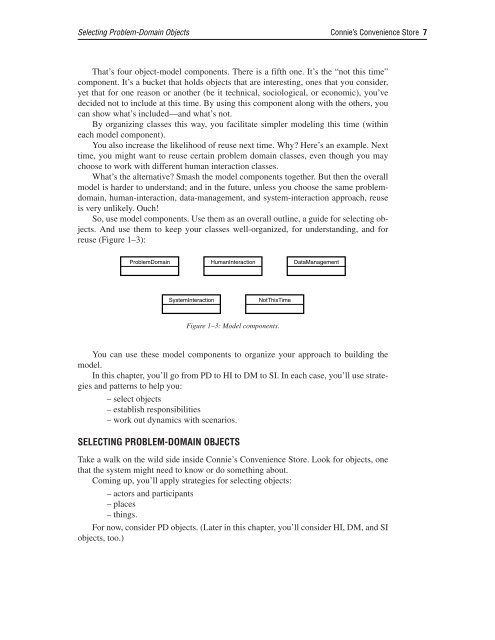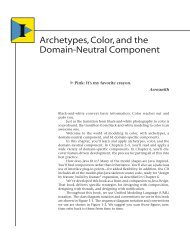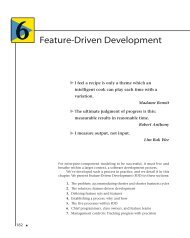Connie's Convenience Store - About Peter Coad
Connie's Convenience Store - About Peter Coad
Connie's Convenience Store - About Peter Coad
You also want an ePaper? Increase the reach of your titles
YUMPU automatically turns print PDFs into web optimized ePapers that Google loves.
Selecting Problem-Domain Objects Connie’s <strong>Convenience</strong> <strong>Store</strong> 7<br />
That’s four object-model components. There is a fifth one. It’s the “not this time”<br />
component. It’s a bucket that holds objects that are interesting, ones that you consider,<br />
yet that for one reason or another (be it technical, sociological, or economic), you’ve<br />
decided not to include at this time. By using this component along with the others, you<br />
can show what’s included—and what’s not.<br />
By organizing classes this way, you facilitate simpler modeling this time (within<br />
each model component).<br />
You also increase the likelihood of reuse next time. Why? Here’s an example. Next<br />
time, you might want to reuse certain problem domain classes, even though you may<br />
choose to work with different human interaction classes.<br />
What’s the alternative? Smash the model components together. But then the overall<br />
model is harder to understand; and in the future, unless you choose the same problemdomain,<br />
human-interaction, data-management, and system-interaction approach, reuse<br />
is very unlikely. Ouch!<br />
So, use model components. Use them as an overall outline, a guide for selecting objects.<br />
And use them to keep your classes well-organized, for understanding, and for<br />
reuse (Figure 1–3):<br />
ProblemDomain HumanInteraction<br />
SystemInteraction NotThisTime<br />
Figure 1–3: Model components.<br />
You can use these model components to organize your approach to building the<br />
model.<br />
In this chapter, you’ll go from PD to HI to DM to SI. In each case, you’ll use strategies<br />
and patterns to help you:<br />
– select objects<br />
– establish responsibilities<br />
– work out dynamics with scenarios.<br />
SELECTING PROBLEM-DOMAIN OBJECTS<br />
DataManagement<br />
Take a walk on the wild side inside Connie’s <strong>Convenience</strong> <strong>Store</strong>. Look for objects, one<br />
that the system might need to know or do something about.<br />
Coming up, you’ll apply strategies for selecting objects:<br />
– actors and participants<br />
– places<br />
– things.<br />
For now, consider PD objects. (Later in this chapter, you’ll consider HI, DM, and SI<br />
objects, too.)




